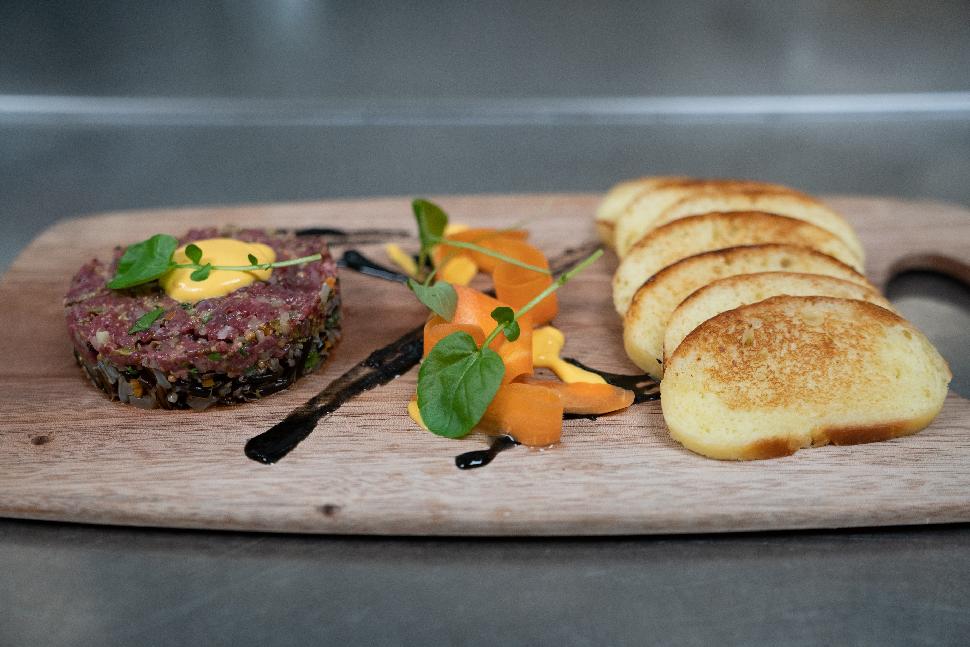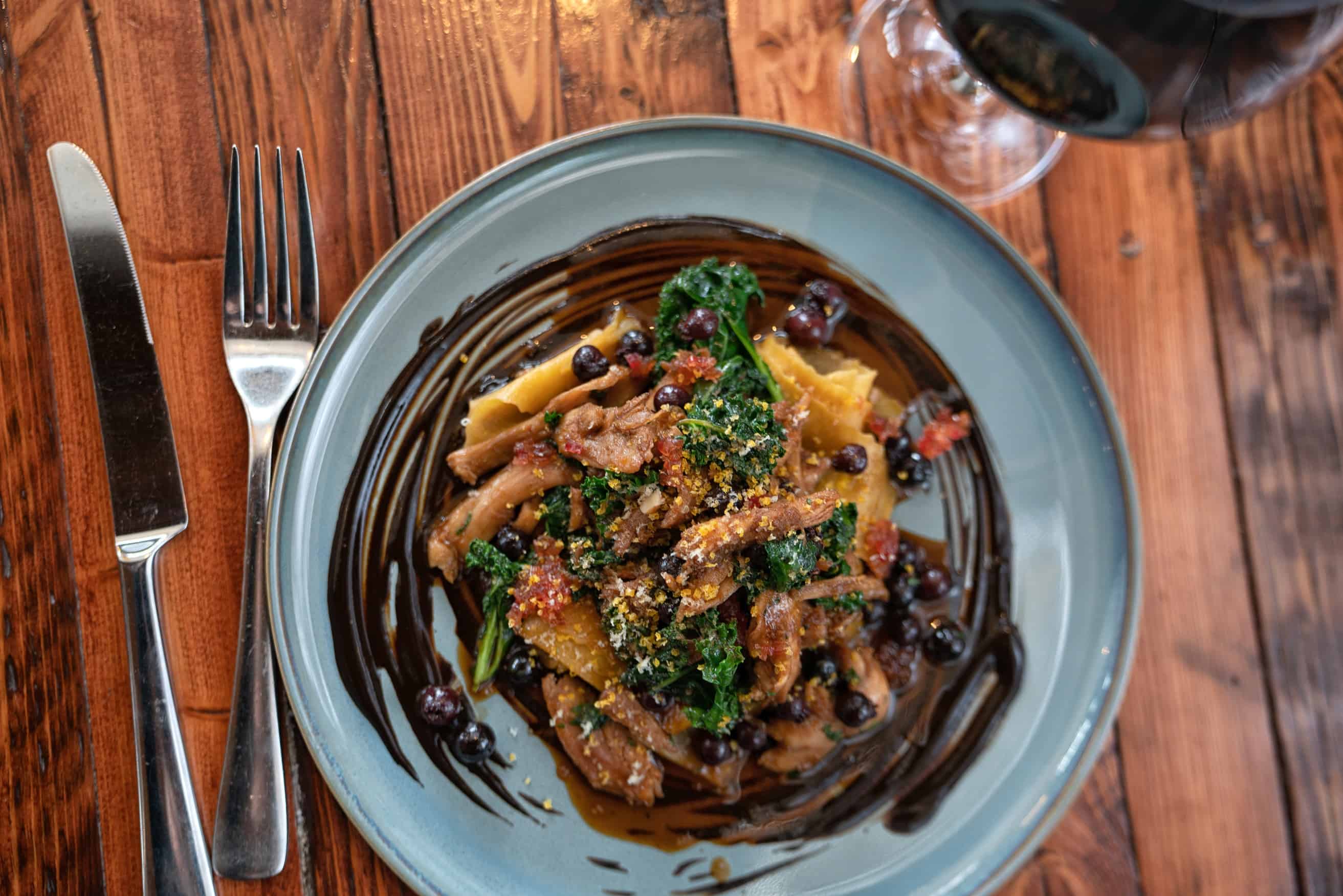
What is traditional Canadian food? Can it really be poutine, Nanaimo bars and beaver tails? Is it the food we serve in our homes? Whose homes? More pointedly, where is Indigenous fine dining in Canada’s commercial foodscape? Jennifer Hubbert travels to Osoyoos, B.C. to bite into the complexities of decolonizing Canadian cuisine while getting a taste of the nation’s long-overdue Indigenous dining revolution.
 The Bear, The Fish, The Root & The Berry
The Bear, The Fish, The Root & The Berry
IN ITS PAST LIVES, the restaurant at Spirit Ridge Resort in Osoyoos, British Columbia has been many things. Generally, gourmet, often Italian-inspired, but mostly predictable.
Sitting upon the traditional land of the Syilx People and overlooking the vines of Nk’Mip Cellars, the venue’s newest concept is joyously apt. Since opening in April, The Bear, The Fish, The Root & The Berry has been introducing guests to Indigenous fine dining under the stewardship of Chef Murray McDonald.
 Chef Murray McDonald
Chef Murray McDonald
The restaurant’s name is a nod to the four food chiefs: “bear” represents land-roaming protein, “fish” embodies seafood, bitter “root” symbolizes vegetarian and vegan dishes, and the Saskatoon “berry” represents dessert. Menu items intuitively fall into one of the four categories, but otherwise, nothing else is quite so simple.
“One of the things our group is tasked with is trying to sum up what Indigenous cuisine is,” explains Chef McDonald. “Coast to coast, you’d swear to god it wasn’t the same food.”
Take for example, bannock; a food that’s widely recognized as an Indigenous staple.
“The weird thing about bannock is that it’s not actually an Indigenous food. It’s a survival food forced upon them by my ancestors,” McDonald remarks, acknowledging the duality of his mixed European-Indigenous background in the same breath. His heritage represents both the colonizer and the colonized. “You’re stuck on a reservation and you’re given a bag of flour, salt and baking powder. Some nations hate [bannock]. Others embrace it. A lot of guys I talk to, they say, ‘Chef, it shows the struggle of the people and how resilient they are.’ That they made something so beautiful, so simple, out of nothing.”
 Bannock & Spreads
Bannock & Spreads
Diners will find varying styles of bannock served at The Bear, The Fish, The Root & The Berry. There’s a Bannock & Spreads sharing plate, a bannock sandwich and a few fruit-forward desserts, all of which vary in texture and appearance.
“Bannock’s one of those things everyone makes slightly different. Tammy’s bannock (The Bear, The Fish, The Root & The Berry's pastry chef, a member of White Bear First Nations) has the texture of a flaky scone. It’s a thick bannock, so it’s really different. On the dessert menu, there’s a fry bread style of bannock. And Jess’s BBSLT Sandwich is actually Nk’Mip Cellars winemaker Justin Hall’s grandmother’s bannock recipe,” says McDonald.
 Tammi Maki, pastry chef
Tammi Maki, pastry chef
Given the polarizing opinions of bannock, Chef makes a point to note his restaurant first secured the go-ahead of the Osoyoos Indian Band before serving it. “We got Chief Louie and council involved and have their blessing to do it.”
Recipes and politics of bannock aside, Chef points out that much of a traditional Indigenous diet is seasonal and terroir-specific, which lends to the complexity of planning The Bear, The Fish, The Root & The Berry's menu.
“Ultimately, we decided we just can’t [define Indigenous cuisine]. [Our menu] takes influences from across the country... and if Justin’s grandmother made it, that’s traditional enough for us.”
For McDonald, The Bear, The Fish, The Root & The Berry represents a personal journey. A born-and-raised Newfoundlander, McDonald’s European heritage is English, Irish, Scottish and Scandinavian, while his mother’s family is part Inuit from Labrador and his father’s family is Metis.
“My ancestry wasn’t something we talked about,” McDonald remarks of his upbringing. “My grandmother was embarrassed that she was part Inuit in rural Newfoundland. She wouldn’t talk about it. [She] dyed her hair and bleached her skin. From looking at records, the only thing we could figure out is that my great-great grandmother was taken away from her family by the missionaries and given to a Christian family to raise.”
At 20 years of age, McDonald pursued professional cooking as a means to travel the world. He worked in the Caribbean, Mexico, the South Pacific and China before settling into family life in Metro Vancouver where he served as Fairmont Pacific Rim’s executive sous chef. Five years later he pursued a rumour of a conceptional lodging in Newfoundland. That property was Fogo Island Inn.
It was in this role of founding executive chef that McDonald gained notoriety in Canada’s foodscape and where he first took a deep dive into Indigenous cooking and cuisine – albeit by accident.
“I used to do a lot of pre-cooking over a fire at Fogo. One day, Charlie Sark was my helper. He said, ‘Chef, you’re cooking Indigenous food,'" McDonald describes.
Chef took a moment to let the remark sink in.
Yes, maybe I am, he thought.
“I thought I was just getting back to the history of Newfoundland food and survival off the land. I had no idea,” McDonald admits. “I was reconnecting; I was cooking this way before I realized I was.”
In the years that followed, Chef became active in promoting Indigenous cuisine, travelling across Canada for speaking engagements and working with the Indigenous Tourism Association of Canada.
Once the isolation of Fogo Island began to wear on his young family, the McDonalds made a move to Toronto where he served as executive chef at The Ritz-Carlton, Toronto. An esteemed position, to be sure, but he had a nagging feeling he could not ignore.
“Instead of being in Toronto and talking about Indigenous culinary, [I thought] wouldn’t it be cool to move to a reservation and actually do it?” explains McDonald. “For me, it’s been a bit of a spiritual journey.”
And so Chef Murray McDonald found himself in Osoyoos, championing Indigenous fine dining, a dining philosophy long overdue for its place in the mainstream Canadian foodscape.
 Spirit Ridge Resort
Spirit Ridge Resort
WHAT'S NEXT FOR CHEF MCDONALD and The Bear, The Fish, The Root & The Berry? Building out the next season’s menu while continuing to elevate the profile of Indigenous cuisine.
Glance at the menu to see chicken is noticeably scant, featuring in a single dish on the lunch menu. Carnivores choose from domestically raised bison, elk, rabbit, duck and wild caught fish. With his mind on his future seasonal menus, McDonald hopes there exists the possibility of one day offering game meat.
“I believe we’ll be able to serve game meat because we’re on a reservation. We’re looking to work with the Osoyoos Indian Band,” he explains. His logic is as follows: “If I go with you on your land and hunt with your guys, I should be able to serve your meat.”
McDonald notes that during his tenure at Fogo Island Inn, he was able to purchase moose meat from hunters and serve it in the restaurant. “The problem is, all health laws are provincial, not federal, so [any change] will take some time.”
Long-term, McDonald hopes to see the government successfully lobbied to establish an Indigenous food certification, with the aim of permitting certified restaurants to serve wild game, province wide.
 Foraged berries
Foraged berries
But for now, The Bear, The Fish, The Root & The Berry will continue to nourish the minds and bodies of its diners, imparting Indigenous values one plate at a time.
“How do you connect with a culture?” asks Chef. “I think it’s through the food. What’s the one thing [people] never leave behind? The food. They take it with them. It’s never lost. That’s how you understand culture. That’s how I’ve been trying to understand the part of my culture that’s been taken away from me – that I didn’t know existed until I was a teenager. I believe if everyone sat down at a table, drank some wine and shared each other’s food, half the world’s problems would end overnight.”

Our Menu Top Picks
 Salmon platter (Ntytikxw)
Salmon platter (Ntytikxw)
SALMON PLATTER (NTYTIKXW) – Maple candied pink salmon, smoked sockeye, coho ceviche, chum roe, capers, and assorted pickles
BANNOCK & SPREADS – White bean sumac spread, roasted hot pepper corn succotash, beetroot relish, garlic fried tomatoes
 "Askawa" tartare of the land
"Askawa" tartare of the land
“ASKAWA” TARTARE OF THE LAND – Bison, egg yolk emulsion, wild rice, pickles and mustard BISON – Spruce roast, nettles, Hasselback sweet potato, swiss chard, onion petals, What The Fungus mushrooms, spruce jus
LIFE IS JUST A PEACH – Peaches, thyme fry-bread, consommé and ice cream
7 More Chefs Raising the Profile of Indigenous Dining in Canada
- CHEF JOHL WHITEDUCK RINGUETTE, NishDish Marketeria and Catering, Toronto
- CHEF SHAWN ADLER, Pow Wow Café, Toronto
- CHEF JOSEPH SHAWANA, Kū-kŭm Kitchen, Toronto (Reopening soon at 557 College St.)
- CHRISTA BRUNEAU-GUENTHER, Feast Café Bistro, Winnipeg
- CHEF BILL ALEXANDER, Grey Eagle Resort & Casino, Calgary
- CHEF SHANE CHARTRAND, SC Restaurant, Enoch, AB
- CHEF ANDREA CALLAN, Red Fox Club, West Kelowna
When You Go:
Where to stay
 Spirit Ridge Resort
Spirit Ridge Resort
 Spirit Ridge Resort | Jennifer Hubbert
Spirit Ridge Resort | Jennifer Hubbert
Spirit Ridge Resort is an all-service destination resort located in Osoyoos, British Columbia. There are 226 rooms ranging from studio suites to one-, two- and three-bedroom villas which lend well to families and groups. The resort belongs to Hyatt’s Unbound Collection.
What to do
 Spirit Ridge Resort | Jennifer Hubbert
Spirit Ridge Resort | Jennifer Hubbert
On the sprawling property, find Nk’Mip Cellars, Nk’Mip Desert Cultural Centre, two pools and Solterra Desert Spa. While not waterfront, Spirit Ridge has a private beach on Lake Osoyoos which is served by a guest shuttle.
 Covert Farms Family Estate | Jennifer Hubbert
Covert Farms Family Estate | Jennifer Hubbert
Off-resort, visitors can’t ignore that they’re in wine country. Osoyoos bookends the Golden Mile Bench with the neighbouring community of Oliver. Along this bountiful stretch are more than 40 wineries; a great deal of them are estate wineries. Add the must-visit tasting rooms of Covert Farms Family Estate and Moon Curser Vineyards (named the 2019 Best Performing Small Winery by WineAlign National Wine Awards of Canada) to your itinerary.



